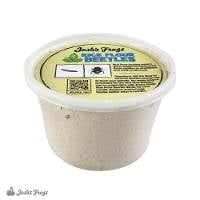Josh's Frogs
Confused Rice Flour Beetle Culturing
Raising and Breeding Rice Flour Beetles
The Rice Flour Beetle, Tribolium confusum, is a common pest in many grain-based foods. The traits that make it a pest species–namely, it's short reproductive cycle, exponential growth rate, and tolerance to a wide variety of conditions–also serve to make the rice flour beetle an ideal insect to culture for a wide variety of reptiles and amphibians that prefer smaller foods, especially poison dart frogs.
Life Cycle
Rice flour beetles are a little over 1/8 of an inch long when adults, and can live for over a year. Adults lay eggs in Josh's Frogs Beetle Batter, which take about a week to hatch into larvae. Within 6 weeks, the larvae pupate and become adult beetles. Due to their longevity and short maturation time, rice flour beetles can quickly increase their population in a culture.

The Confused Rice Flour Beetle, Tribolium confusum
Culturing
We culture rice flour beetles on a special media we make ourselves, in order to insure the Rice Flour Beetles we sell are raised on only the highest quality ingredients. Beetle Batter contains all of the vitamins, minerals, and other nutrients rice flour beetles need to thrive, as well as color enhancers that are passed on to your pet reptiles or amphibians.
Choose a container that seals well, but is not airtight. A plastic shoebox works well when culturing Rice Flour Beetles–this is the Rice Flour Beetle culture container of choice at Josh's Frogs. Place Beetle Batter in the container, to a depth of about 2 inches. Add rice flour beetles to the culture, and ignore the culture for a few months. This wait period will give the beetles time to establish in the culture, before you feed any off to your pet reptiles or amphibians.

Rice Flour Beetles are tolerant of a wide variety of conditions, but will reproduce faster the warmer you keep the culture (up to about 85°F). Do not provide a moisture source–they need a dry culture to do well, and excess moisture will cause the media to spoil.
About once a year, sift out all of the adult beetles and larvae, and replace the old media with fresh Beetle Batter.

An established Rice Flour Beetle culture. Notice that most adults (and all larvae) are typically buried in the substrate.
Feeding to your Pets
The beetle larvae are usually what is fed to your pets. The adult beetles have chemical defenses that make them unappetizing to many reptiles and amphibians, but some will take them. At Josh's Frogs, we sift out the larvae and feed them to poison dart frogs, bumble bee toads, small tree frogs, and some smaller species of geckos.
The larvae need to be separated from the Beetle Batter before feeding. Use the following steps as a guideline to harvesting and feeding beetles to your pet reptiles and amphibians:
- Use a sifter to scoop some of Beetle Batter containing beetles and larvae.
- Shake out the media over the culture. After the media has been sifted out, you will be left with a sifter full of adult beetles and larvae, and shed skin/pupae.
- Set the sifter in the culture, allowing most of the adult confused rice flour beetles to crawl out of the sifter and back into the culture, leaving you with mostly larvae and shed skins.
- Dump the larvae into a small bowl (half of a plastic petri dish works well) and place it into your pet's enclosure. Your animal will chow down on the larvae and appreciate the added variety in it's diet.
Conclusion
Rice flour beetles are an ideal supplemental feeder to a variety of reptiles and amphibians that appreciate smaller foods in their diet. They are very easy to culture and feed out to your pet, making them a must-have for those of you with poison dart frogs or other microphagous critters. We carry everything you need to culture RFBs for your pets!
For more information on culturing rice flour beetles, please watch the following video: How to Culture Rice Flour Beetles



